Lost in Translation Nine
May 11, 2006
08:39 AM
I remember being on a bus once when a soldier, in full uniform, came on board.
There was a mother and a her young but vocal daughter just behind me.
“Whats that Ma ?” said the child, timorously.
“Thats a soldier Pet” said the mother absently
“Would he go near me” said the child in some fear.
“He would not !” said the mother, shocked and looking searchingly at the child.
It also struck me as an odd thing for the child to say.
Until I reversed it.
Think of all the times a child, going down a street for example, sees, again for example, a large dog.
What does the Mother say to reassure but;
“OK love, he won’t go near you”
We don’t always understand when words or phrases,which live on only in their negatives, are used in their positives.
Some great words have been lost in this way, and as now I have people coming to dinner tonight I must cease blogging and and try and make the house lapitated .
Nine Cookbooks Will I Have There
May 10, 2006
13:32 PM
Cooking in a Bedsitter
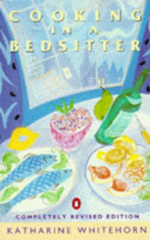
When I moved into my first bedsitter in Dublin
I bought myself this book.
At that stage I was doing a BA in English and History
and would have laughed to scorn anyone who suggested
that I might end up cooking for a living.
I bought the book in Parsons on Baggot Street Bridge and
got on the 18 bus to go and get fed by my sister D
in Rathfarnham.
I started to read the book en route and was so enthralled
by it that I totally missed my stop, ended up in Ballyfermot
having to bus it back to Kenilworth.
I afterwards gave my first dinner party ever from that book
(Sole stuffed with Prawns and Trifle) the defining moment
when I decided that I liked cooking.
French Provincial Cooking
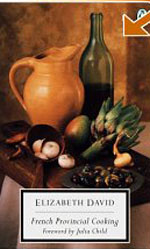
My sister D had a copy of this book and it was well thumbed.
A book which can be read for pleasure.
When I started to cook professionally this was the book
I swotted up to try and achieve some degree of knowledge
about cooking.
I used her Chicken Liver Pate endlessly, made it professionally for years. likewise her Bouef Bourguignon and her Terrine de Campagne.
Principally though it is just for the pleasure of reading a beautifully
written book that I would put this at my number one position.
Four Seasons Cookbook
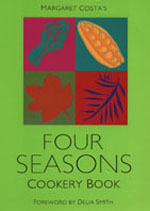
Margaret Costas book is just loaded with ideas.
For every recipe she gives she throws another six in at the end.
This is the essential book to pick up when your mind will no longer
give up a suggestion, and you have someone coming to dinner.
Good Things
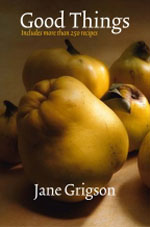
This is just what it says it is.
Jane Grigson’s pick of her own favourite foods
and how she cooks them.
It was the only cookbook we had in England during our
first six months living there and I think I have cooked j
ust about every recipe from it.
They all worked.
Greater praise hath no Chef…
Leaves from a Tuscan Kitchen
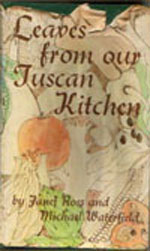
Michael Waterfield is daughter Caitriona’s Godfather
but were I never to have met him I would still love this book.
Janet Ross loves her vegetables and cooks them with skill
and relish.
This book is more important today than ever before.
The Constance Spry Cookery Book
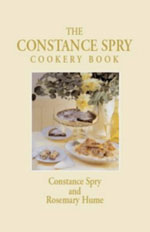
My bible, every sauce, roasting time, type of cake is given
by the inventor of Coronation Chicken (NOT her best dish).
Keep this not just for reference though, the food she gives
directions for is delicious.
Ballymaloe Cookbook
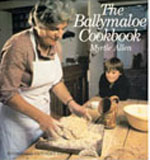
I am proud to call Myrtle a friend and her book is
now recognised as a classic.
The mother of Irish cooking tells you not only how
to cook superb food but also how important it is to source
the ingredients properly.
Should be compulsory reading in catering colleges.
North Atlantic Seafood
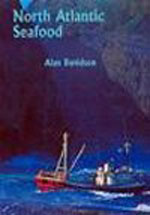
The book for fish, the what and how of the sea.
Reference, inspiration and direction all in one .
I am so grateful it was reprinted a few years ago.
My original copy was in tatters but still essential.
Canteen Cuisine

Strange inclusion this but it was the book I used most
during my latter years in the restaurant.
The section on sauces in the back is simply excellent.
This man knows and loves his onions.
Fish and Chips
May 8, 2006
23:51 PM
I know that as an erstwhile chef stroke proprietor of an upmarket restaurant the last dish I should be championing is fish and chips.
However as a part time house husband, cooking for two rather than thirty two (it was a small restaurant) we are beginning to recognise that our favourite dinner is a variation of fish and chips.
If I were to call it Breaded Hake, Shallow fried in Olive Oil with Sauté Potatoes it would, even if more accurate, be definitely more pretentious.
It is Fish and Chips in a lounge suit however, not yet in a dinner jacket but certainly not in jeans.
For two people you will need 500g (1 lb.) of thick Fish.
My preference is Hake but it also works very well with Cod or Haddock or even Plaice should one find one which is thicker than paper.
Other ingredients are an egg, about 150g (5 oz.) breadcrumbs
4 or 5 Medium potatoes , a plentiful supply of olive oil and salt and pepper.
First start with the potatoes.
Peel these and then cut into 2cm (½ ins.) pieces.
Rinse these in some cold water and then drain and dry on a tea towel.
(This is essential for the floury Irish spud, should you know that your potato is of the waxy variety you can leave out the preliminary rinsing)
Heat some olive in a large pan and fry these in the oil until browned in the outside and cooked inside.
Salt and pepper them as they cook.
This will take about 15 to 20 mts.
They will need to be tossed from time to time to insure even cooking.
Search the fish carefully with your finger tips for bones and remove any you find, leave the skin on.
Cut the fish into pieces about twice the size of the diced potato.
Break an egg onto a plate and beat to break up.
Scatter the crumbs on another plate.
Dip the flesh side only of the pieces of fish into the egg and then the crumb and then cook crumb side down in a pan of hot oil until brown on this side.
Then turn on to the skin side , lower the heat, cover the pan and cook for another 4 to 5 minutes until the fish is cooked through.
Serve this with the sauté potatoes and some mayonnaise (home made if possible) and a fresh lemon to squeeze over-or indeed, to be more traditional,- a bottle of malt vinegar with holes pierced in the cap.
Whines of a Grumpy Old Man
May 8, 2006
13:45 PM
Why are;
All shirts (except those mail ordered at great expense) designed to expose a paunch the minute you raise your arms.
The labels of underpants sewn in with nylon gut of a rigidity to necessitate me to wear all of these garments inside out to avoid at least serious itch or, at worst, scarring of the lower back.
Deodorants infused with such powerful and acrid perfumes as to make one smell like cheap air freshener
All liquid soaps in hotel toilets infused with the same.
If Michael O Leary regards his airline as a bus why does he not make it as easy as getting on a 46A
Why do:
All racists preface their racist statements with “I’m not racist but…..”
We not enforce the law on people with dogs who foul the pavements. When was the last time you saw someone pooper scooping? What about mandatory jail for offenders?
People persist in putting my life in danger by passing me out in their cars at blind corners (if it is suicide they are after fine, but don’t involve me please)
Walking the Railway Line 3
May 8, 2006
09:44 AM

Yesterday Sile and I got out the bikes and cycled as far as Mount Congreve where there is another part of the old Dungarvan Railway Line.
This part has been reclaimed by the Suir Valley Railway Company so we had the pleasure of walking on railway tracks that were in use.
If you look carefully in the middle distance of this shot you will see the little train on its way.
Rhubarb for Grown Ups
May 5, 2006
14:19 PM
We eat a lot of rhubarb here in Ireland, we always have.
It grows well in our climate and fits in well with our favourite dessert format of tarts or pies and also with that dying (and badly named ) dessert of stewed fruit.
I feel that one of poor rhubarb’s misfortunes is its long tradition of being healthy, especially in the Victorian sense of the word.
The Victorians were of the mind that most of life’s ill could be solved with a good bowel movement.
Rhubarb with its undoubted laxative properties was then wheeled out fairly regularly to ensure regularity.
In our house growing up it was called “Tip and Run” or “Touch and Go”
This has nearly been the kiss of death for it.
Plus, there is nothing all that appealing in a dish of stewed rhubarb.
All that watery and stringy mass of over sweetened acidity convinces us that what is good for us is surely nasty.
I have cooked a lot with rhubarb over the years, cooking it in the microwave without any water keeps both its crunch and concentrates its flavour.
Cooking it with ginger gives it an appealing bite, with orange zest a pleasant orange spiciness.
Most of those I have already done this rhubarb season.
A friend who is lucky enough to have a kitchen garden gave me a present of a large bunch last week end (thanks Grace)
Deciding that I wanted to do something different with it I remembered tackling a Rhubarb Fool from Margaret Costa a long time ago.
Margaret Costa’s Four Seasons Cookbook was published in 1970 and is a cookbook of great quality. I still have my original copy, one of the first cookbooks I ever bought but it was reprinted last year and is fairly freely available.
The sentence with had stuck in my mind from this book in relation to the fool was the following;
“And there’s a secret ingredient: 2 small teaspoons of Pernod.The Aniseed flavour is barely recognizable but everybody notices that the fool is curiously delicious”
Good on you Margaret!
It is curiously delicious indeed.
I didn’t have any Pernod in the house so used some Absinthe bought in Alsace a few years ago, also I added a little more than the two teaspoons she suggested so rather than a “barely recognizable” you get a whacking great wallop of liquorice.
This is delicious but the subtle approach may well be more to your taste.
Here is a rough recipe.
For every pound (500g) of rhubarb(leaves discarded) you will need about 90g (3 oz.) of caster sugar.
Chop this roughly and cook without any water in a covered bowl in a microwave until it is just soft.
Put this into a liquidizer (if you only have a food processor whizz in this but I would sieve it afterwards to get it really smooth)
Taste after liquidizing and then add more sugar if you want and then add the Pernod, as little or as much as you fancy, my taste would be about 4 teaspoons.
To serve the fool you can eat this just as it is in individual cups or glasses or mixed with the same amount of whipped cream or Crème Fraiche.
Traditionally you should have some shortbread biscuits to dip in it .
Lost in Translation Eight
May 5, 2006
11:00 AM
One is particularly inclined to get lost in translation when travelling between two different languages, an obvious thought I know but if you skim back through my other six “Lost in Translations” you will see that most of them are about people who claim to speak the same language misunderstanding each other.
A school friend of mine was half German and had an aunt to stay who spoke absolutely no English.
She was left alone in the house in Cork one morning when the breadman called looking for his daily order (this was the sixties when such calls were normal).
Terrified of having to try and communicate in an unknown language the aunt produced one of her few English words. She knew that “Morgan” in German meant tomorrow which was the day she wanted him to return.
Unfortunately “Morgan” also translates as “Morning” which was the word she delivered to the breadman. To which he politely replied “Morning! And what bread would you like today?” This apparently went on for some time. The breadman thinking he was up against some arcane German greeting ritual and the aunt getting hysterical.
Another traditional minefield was the Irish Au Pair having her first trip abroad with her careful lexicon of convent filtered French.
The classic, and maybe apocryphal, story is of the Au Pair having dined extremely well, and, being pressed to have some more, declared herself full.
She gave “Je suis plein” as her reason for stopping.
She couldn’t for the life of her understand the consternation that then ensued.
How was she to know that “Plein” is the vulgar French for pregnant.
Feebly trying to rescue an obviously now hysterical pere et mere she decided to elucidate her state of satiation by explaining that she was in fact, finished.
She said “Je suis terminé”
This only caused the mounting hysterics to redouble in volume.
The family, wondering how they were going to survive the first blow had now been reliably informed that their Au Pair was not only pregnant but also dying!
Terminé in French meaning finished in the literal sense.
I never did hear how the situation finally resolved itself.
My own lost in translation experience in Italy was not resolved finally until we returned from our holidays.
We had rented a gorgeous villa in beautiful Tuscany and, unusually for us who were more used to cool French welcomes, were visited on the first night by our landlord. The villa had been booked through an agency and until he met us he had assumed us to be English.
When he discovered us Irish his eyes glazed over and he said;(he had not one word of English and us not much more Italian)
“Ah ! Irlanda! and then something that sounded like “Aw key!”
At our obvious lack of understanding he then, and he was small and fat, proceeded to dance around the room flapping his wings, stopping occasionally to level an imaginary rifle at the heavens and say bang! bang!, followed by a fairly good imitation of the dying swan.
This went on until we all collapsed in laughter, bonded by mutual lack of communication.
We never did find out what he was trying to tell us during the time we stayed there, but we became great friends
When we got back to Ireland we eventually worked out that the man was a huntsman and had a burning ambition to get to Ireland, one of the few places where wild geese;”Oche” could be legally shot.
Spices
May 3, 2006
11:37 AM
My friend Isabel sent me an email this morning detailing a recent controversy she is having with her patchwork group about the colour which is called Cardamom.
She had referred them to my Cardamom cake recipe but I myself feel this hadn’t helped a whole lot.
Being on occasions literal in my approach I couldn’t resist spilling some pods out on a plate to show her their true colour.
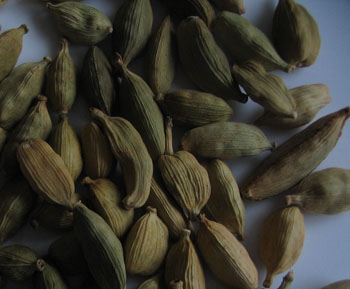
Then of course it struck me that maybe the colour should refer to the ground spice so I had to photograph that as well, this looked so pretty that I ended out spilling all of my spices out on a plate to photograph them
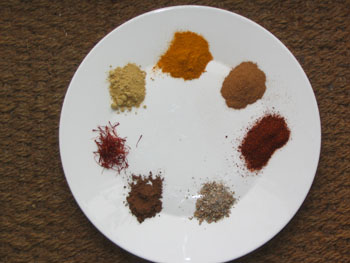
These are, from 12.O Clock, clockwise
Turmeric, Cinnamon, Paprika, Ground Cardamom,
Allspice,Saffron and Ginger.
Now I am going to have to spoon them all carefully back into their boxes.
This is all your fault you know Isabel!
As for the colour of Ground Cardamom?
I think it could best be discribed by a phrase used by the citizens of New Ross in County Wexford ;
Dun Duckety Mud.
1 comment.
Walking the Railway Line 2
May 2, 2006
19:30 PM
In march of last year we took a walk along the railway line
with some friends of ours.
We were walking along the old, and now disused Waterford
to Dungarvan line.
Last Monday we walked another section, finishing up with
a picnic by the side of the old track.

A battered signal indicated its original use.
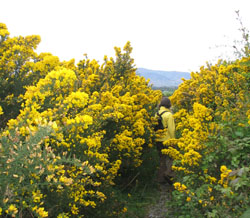
The track glowed with blooming Gorse.

And the yellow catkins of willows.

The Victorian engineers had built the line with great skill.
The basic structure has withstood elegantly the many tests of
both taste and time.
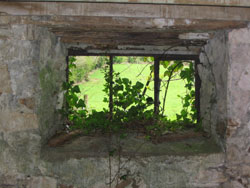
Through the window of a long abandoned farm.
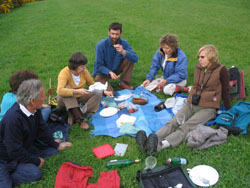
Picnic
El Pa Y All
May 2, 2006
10:34 AM
Having supper with my friends Micheál and Sonya last night I was offered a starter of startling and delicious simplicity.
They sliced pieces of French loaf along the length and then grilled these on top of their range.
Then they handed these around with a supply of halved but unpeeled cloves of garlic, some halved sweet cherry tomatoes , some good olive oil and the pepper grinder.
They explained to us that all we had to do was to rub the grilled bread with the garlic, then with the tomato, sprinkle over the oil and then grind over a little black pepper.
The result was so fresh and delicious that we all managed to consume far too many.
I knew that I had come across this before and a little research into Elizabeth David this morning gave me the reference.
She gives this recipe in French Country Cooking which was first published in 1951, fifty five years ago.
I will quote the entire directions she gives;
El Pa Y All
The breakfast dish of the Catalan peasants in the Roussillon district of France.
A piece of bread fresh from the baker( or sometimes fried in oil or pork fat) is rubbed all over with a piece of garlic, as little or as much as you like; then sprinkled with salt, then a few drops of olive oil , and then the Pa y All is ready
What could be simpler or more delicious.
The further point of interest is that Ms. David comes back to the recipe in an article she wrote in 1963, this was not actually printed until included in An Omelette and a Glass of Wine in 1984.
Writing about Pa y all she has this to add;
When the book first appeared in 1951, one reviewer remarked rather tartly that she hoped that we British would never be reduced to breakfasting off so primitive a dish.
I was shaken, not to say shocked- I still am- by this smug expression of British superiority and by way of revelation, unconscious, of the reviewer’s innocence.
Believing , no doubt, that a breakfast of bacon and eggs, sausages toast , butter, marmalade and sweetened tea has always been every Englishman’s birthright.
How much more supercilious does that reviewer seem in 2006.
And how very tasty and indeed healthy does the Catalan breakfast seem today,especially when compared to the British Fry.
But now the eagle eyed among you will be wondering where are the tomatoes as eaten last night.
At the end of her article in “Omelette” Ms. David quotes a very recent letter she had received from the wine writer Gerald Asher.
He writes from Sitges in Spain;
“Waiting for lunch one is given a basket of hot grilled bread, a clove of garlic, a tomato salt and olive oil”
It seems that Micheál and Sonya were serving Pa Y all as eaten in Spanish Catalonia.
For anyone who is wondering, my guess, even though I speak no Catalan, is that the dish translates into English as Bread and Garlic.
|
